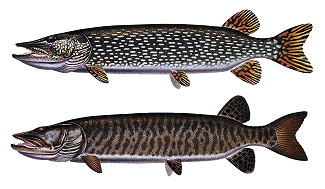Last time in Panfish, Randy Fratzke discovered
a toothy critter, a big Northern Pike eating
ducklings and raising havoc on his stretch
of river. He has vowed to catch this Pike!
While this saga unfolds, (and until we get another
installment) let's take a look at Northern Pike and
their very close relative the Muskie. The following
text and photos are from Fly Rod Gamefish.
Our thanks to Cowles Enthusiast Media
for use permission.
"A sea of misinformation surrounds the northern pike
and muskellunge. Even today we hear stories of huge
pike or muskies attacking swimmers or charging outboard
motors. Such tales make good copy in magazine articles,
but only serve to perpetuate the "evil" image of these
fish.
Of course, pike and muskies are the top predators in
any body of water, and they'll eat larger prey than most
other freshwater fish. But they're not the ruthless
killers they're commonly portrayed to be.

Northern Pike (Esox lucius) - Also known as
northern, great northern pike, jack, jackfish,
pickerel, brochet, luce, gator, snake. The sides
vary from dark green to olive green to brown, with
gold flicks and 7 to 9 rows of yellowish to whitish,
bean-shaped spots. The underside is white or cream-
colored. The dorsal and anal fins, which are set
far back on the body, vary from greenish to reddish
and have irregular black marks, as does the tail. The
entire cheek and top half of the gill cover are scaled.
The duckbill-shaped jays have long, sharp teeth; the
roof of the mouth, pads of shorter recurved teeth.
The underside of the jaw usually has 10 sensory pores.
Muskellunge: (Esox masquinongy) Also
called muskie, lunge, maskinonge and innumerable
other local names. Resembles the pike in most
respects, but the background color of the sides
is light, rather than dark, and the tips of the
tail are more pointed. The sides vary from greenish
to brownish to silvery, usually with dark markings,
but the marks may be absent. The white or cream-
colored belly often has brownish or grayish spots.
The fins vary from greenish to brownish to bloodred
and usually have dark markings. The cheek and gill
cover have scales only on the top half. The number
of pores on the underside of the jaw varies from
12 to 20, but the count is usually 15 to 18.
To become a proficient pike or muskie angler,
one must put aside the backlog of misinformation
about these fish and learn more about their
behavior and biological requirements.
Northern pike and muskellunge, along with
pickerel, are sometimes referred to as Esocids;
they belong to the pike family, whose technical
name is Esocidae.
Pickerel also belong to the pike family, but
are much less popular with anglers because of their
small size. Chain pickerel seldom exceed 5 pounds;
redfin pickerel, 1 pound.
Northern pike hybridize with all other species
of Esocids. The best known of these hybrids, the
tiber muskie, is a pike-muskie cross. Tiger muskies,
which get their name from their distinct vertical
bars (opposite), are rare in nature, because pike
spawn so much earlier than muskie.
But fish hatcheries can easily produce hybrids, and
the fish have been widely stocked in the United
States. "Hybrid vigor" makes them grow faster
than either parent, at least for the first several
years of life. Tigers do not reach the ultimate
size of purebred muskies because their life span
is shorter." |




